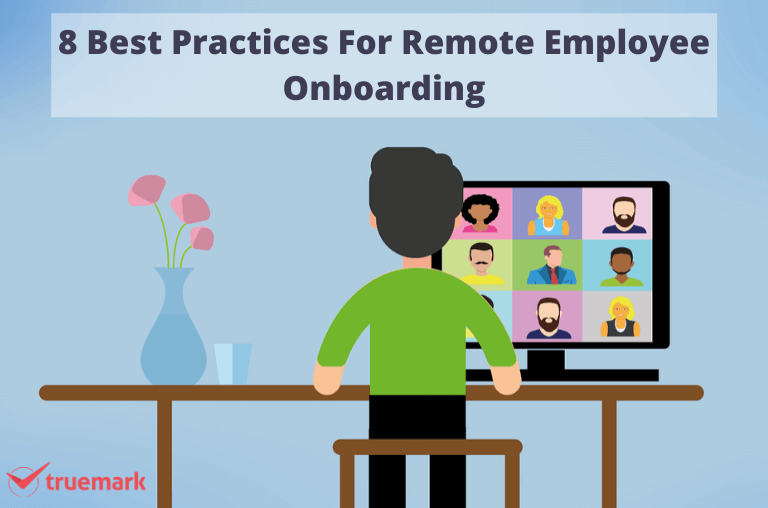According to Small Biz Genious, the number of people working remotely has increased by 140% since 2005. The State of Telecommuting has stated that telecommuting has grown by 115% in the past decades.
The trend of working from home is increasing rapidly. Since the pandemic, it has more than doubled. People are currently working remotely more than ever. Upon realizing how effective remote working is, many companies have shifted to remote working. And there is a high chance that many employees will fully adapt to the current environment and never return to the office.
With the increase in remote working, it has become crucial to manage remote employees. However, the most prominent challenge is to onboard new remote employees to the company. Employee onboarding is the process of introducing and familiarizing the new employees with the company and its culture to help them settle down.
If onboarding is done correctly, the employees are 18X more likely to feel highly committed to their companies.
So, to make it effortless for you to make the onboarding process smooth, we have put together a list of the best practices for remote employee onboarding.
But before that, let’s have a quick look at the challenges you are likely to face during remote employee onboarding.
Challenges in remote employee onboarding
With hiring new remote employees comes different challenges. Even though remote working isn’t new, many companies are still facing problems when onboarding them.
So, here is a list of challenges.
Organizational challenges
From the perspective of an organization:
Explaining the company’s process
Without the office tour and face-to-face interaction, it is tough for an organization to define its culture and processes to the remote employees. Even if it goes smoothly, there always remains a question- Did the employee get it?
What if the employees don’t go through the guidelines? Most of the time, for many companies, this remains a mystery. Moreover, it might be challenging for the employees to get most of the information if it is a lengthy process.
Setting up the right tools
Another challenge for the organization is setting up the right tools for the employees. It has to make sure that the needed tools are correctly installed on the employee’s pc. However, there is always the chance of getting errors while doing so. In such a case, it will be difficult for the company to solve the issues immediately. If it’s while in the office, then that’s a different story.
Lack of engagement
What if the employees aren’t engaged as expected? Are they able to deliver on time? Such questions always trouble the organization.
Moreover, new employees are always excited to be a part of the team. They are high in energy and morale. They are always curious about what their new tasks and roles will be. However, many companies fail to realize this and waste the opportunity to keep the employees engaged. They limit them to do some paperwork sometimes. This completely kills their excitement.
Continuous support
Another challenge is to give them continuous support. While onboarding new remote employees, it is crucial to provide them with the support they want. They want to be a part of their new family. Sometimes, the company fails to do this. This could be because the organization is short in the workforce to check on them.
Remote employee challenges
From the perspectives of remote employees:
Learning the company’s culture
As stated earlier, if it is a lengthy process, employees might not get everything. This is always challenging for the employees to know everything about the company, how it works, the process and workflows to do a task, etc. It takes time to understand everything. And they will get it once they have settled down.
Sense of isolation
Working remotely has many benefits, and this favors many employees. However, some people prefer working in the office. Such people get lonely once they start working from home. No colleagues to chat with, have fun, and work together. There won’t be any time to build a good relationship with others. That is why feelings of isolation arise.
Getting attached to the team
Remote working has many downsides. Not getting time to bond with team members is one of them, which is tough to do when working from home. Everyone will be busy carrying out their responsibilities. They might get time to talk when they discuss the projects and the tasks only. Besides these, there will be hardly any time for anyone.
Communicating
New employees need to communicate with other members of the organization. Otherwise, the situation will be disastrous if no one knows the projects and tasks’ status. However, the new employees might hesitate to ask and report anything at the initial stage.
Moreover, it might be problematic for the new employees if they don’t know who to ask for advice and feedback when they have problems. Even if they request help, what if the response is late? For such a situation, the company must have a way to resolve it.
Practices for remote employee onboarding

Unlike commuting to the office, the company has to manage everything and onboard remote employees through online communication channels. The lack of person-to-person interactions makes it harder for the organization and the employees to establish a good bond. Not really hard, but it takes time to build a good relationship.
But it doesn’t mean that is always the case. There are successful remote companies as well.
So, here are the best practices for remote employee onboarding to overcome the challenges.
Explain the company’s culture
When a company hands its guidelines and documents to the remote employees, they likely won’t go through it. So, how can an organization communicate the company’s culture by not making it dull then? Well, at an initial stage, explain to them in brief about the working process and culture. Make it short.
Besides, you can hand over presentations or videos about the company’s culture. It is more convenient than reading a document.
Moreover, focus on basics, like the communication process, Q&A session, etc. While a company must make sure that the employees know its culture, it is also essential to give them time. Gradually, they will learn about the company’s way of doing things and adapt the right way. Initially, mistakes may occur, but that is also a way of learning.
Moreover, the company needs to develop onboarding practices priorly. As time passes, it will be effortless for an organization to be more efficient when hiring new remote employees.
At Truemark, we have our own onboarding process. We follow it whenever new remote employees are hired.
Make it clear about the expectations and roles.
It is not always easy to supervise your employees when they are not in the office. Moreover, they are always looking forward to doing their best. So, it is good to delegate their roles and responsibilities. Let them know what their tasks are for today and plan for tomorrow. Communicate the expectations clearly.
Clarify what you expect from the remote employees and when they should do it. Give them tasks through Slack or any other communication channel. Otherwise, it will create confusion and may lead to more significant problems in the future.
Moreover, you can assign them easy tasks or train them to make them more comfortable and boost their confidence.
Create a sense of belonging
Feeling of isolation is common when working remotely. There is no one around you to chat and work with you. So, the company needs to create a connection right away with the new remote employees. So, how to do it?
Send a warm welcome message to the remote employee and host a video call. That is what we do at Truemark. We announce when a new member joins us on Slack. Everybody welcomes him/her. This helps everyone to connect with each other. Moreover, it is essential to build connections with them to make them feel like they are part of the family.
The company should create a friendly environment so that remote employees don’t feel left out.
Introduce remote employees to the team
One way to help remote employees build connections and a sense of belonging is by introducing them to the team. This allows them to ease up, boost confidence, and get frank with everybody. Most importantly, it helps to eliminate the feeling of isolation.
Hosting weekly Zoom calls is the best way to build connections and know about its culture and process. This makes it easier for new remote employees to adapt to the working environment right away.
At Truemark, we host a Zoom or Google Meet call involving every member and introduce them to each other to get closer to new employees and build connections. We usually talk about any issues while working, how the day is going, ask and give feedback, etc. We do this time-to-time, if not regularly.
Host virtual meetings time-to-time
Hosting virtual meetings time-to-time is an excellent way to onboard remote employees. Everyone attending the conference call might not be feasible sometimes, but those available are good as well.
Or, one-on-one is also an excellent way to build connections. Doing this helps remote employees to be open about the problems they are facing.
Assign a mentor
New employees with mentors tend to make fewer mistakes and adapt to the company’s culture faster. Moreover, this helps them to be more productive and build connections. So, a company needs to assign a virtual mentor to support the new employees and train them.
Moreover, it is essential to nurture them and improve their skills and knowledge. Plus, it helps them to boost their morale and motivation.
In addition, new employees tend to be more hesitant to ask questions when they have just joined the company. So, assigning a mentor or a buddy is a great way to make them feel comfortable.
At Truemark, new employees are trained and mentored by one of the employees. It helps them to adapt to the working culture faster.
Help remote employees to set up the tools.
First, the company needs to invest in the best software. It is essential to make sure that every work is done smoothly and without any problems. Then, it should help the new remote employees to set up the tools.
Not only setting up, but the mentor should also help him/her use the software. To make it easier for them, the company can list all the tools to be installed and create guidelines to use them.
Moreover, the company must provide access to the tools and documents to ensure better collaboration and teamwork. And make sure that they are set up correctly on their pcs so that nothing hinders their work, and the employees are productive.
At Truemark, we make sure that the tools are installed correctly on everyone’s pc. If errors occur, we help them through video conferencing or screen sharing.
Communicate regularly
Besides weekly or monthly virtual meetings, it is crucial to communicate with the new remote employees regularly. It is essential to ask for their experience working in a new environment with new people.
Moreover, it is also crucial to know if the new employees are having any issues or struggling to keep up with the tasks. Misunderstandings and problems may occur at any time. So, communicating regularly is essential. This is what we do at Truemark. We host virtual meetings almost every week. Plus, every employee must post daily standups, which makes communication and progress tracking smooth.
Besides these, it helps to build strong relationships with the employees. Also, it helps to clarify and address if there are any concerns.
In Conclusion
With the increasing trend in remote working, it has become necessary for businesses to manage and onboard remote teams. You may come across many challenges. However, these practices will help you overcome them.
Make the remote employee onboarding process smooth, efficient, and successful with the help of these tips.
If you need help developing software or have any suggestions, please feel free to contact us. We will be glad to help you.



